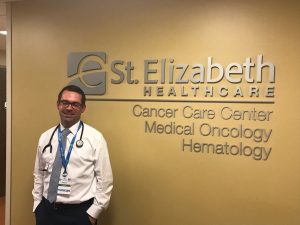By Mark Hansel
NKyTribune managing editor
For decades chemotherapy has been synonymous with cancer treatment, but the post-diagnosis approach meant patients were already ill, often very ill, before curative efforts began.

St. Elizabeth Healthcare physician Dr. Daniel Flora says clinical trials are really the only way to discover new, more effective methods of cancer treatment (photo by Mark Hansel).
Advances in genetic testing now allow physicians and researchers to offer methods of identifying and treating cancer that were not considered, or even understood, not that long ago.
Dr. Daniel Flora, a cancer care physician at St. Elizabeth Healthcare specializing in medical oncology and hematology, explained how St. E’s Cancer Care Clinical Research efforts are essential to driving those advances.
“We have sort of a two-pronged approach to treating cancer,” Flora said. “One is prevention and advanced diagnostic and gene testing to try to find cancers before they ever happen. We may start to open up options for clinical trials for patients to be screened for cancer before they ever develop it.”
St. E physicians have found an effective way to try to get patients involved and engaged is through prevention studies and the use of precision medicine.
“When patients do develop cancer, we often times are now testing the genetic profile of the cancer itself to identify new, novel therapies that would be a lot more focused for their particular cancer,” Flora said. “It’s sort of a targeted, or smarty-bomb type of medication, rather than chemotherapy, which is really not a very smart way of treating cancer.”
Chemotherapy doesn’t hone in on the particular type of disease, it just treats the whole cancer.
The ability to identify a genetic profile is seen as a game-changer in cancer treatment. Genetic profiling is a laboratory method used to learn about all the genes in a person or in a specific cell type, and the way those genes interact with each other and with the environment.
“The idea of being able to identify a particular genetic signature of a cancer, to be able to put those patients on a clinical trial, that matches exactly with the type of gene mutation they may have, is extremely attractive,” Flora said.
Most of the nation’s largest cancer programs are already moving toward that, as is St. Elizabeth.
“We have no less than four trials in the works right now where the patients will be able to have their entire genomic profile made up, as well as, if they have cancer, their cancer genomic profile,” Flora said. “One thing the community may not understand is that people can have their own genetic makeup, but the cancer has a unique genetic makeup as well.”
The goal is to identify both of those and develop a treatment plan that is the best fit for each individual patient.
“If a patient has a BRCA gene mutation, they are at risk for breast cancer, but we may also find out that if you have a BRCA gene mutation, you may be a candidate for a drug that works better in patients that have that genetic mutation,” Flora said. “
Put simply, doctors are just getting a lot smarter about identifying the patients who are going to be at risk and developing individual treatment options.
“Our main goal here is to have as much information as you can possibly get about a patient’s tumor and then use that information in a precision manner rather than a shotgun type of approach,” Flora said. “So, many of the cancer clinical trials that we want to bring here would be matched up with that. That’s really how it fits in with the genomics program because you are going to identify these folks and then you may have a particular targeted therapy that might prevent, or treat their cancer.
‘On the cusp of a revolution’
It is an exciting time in the world of cancer treatment and doctors are now discussing new treatment options with patients who had little hope just a few years ago.
“Certainly newer therapies like immunotherapies, completely change the landscape of cancer treatment, so nowadays a good number of your patients no longer have to undergo the significant toxicities of chemotherapy,” Flora says. “For example, we have an immunotherapy study right now for pancreatic cancer, which is one of the only in the Midwest. That’s an opportunity — it gives hope to patients who previously may not have had any other treatment other than chemo, which doesn’t work very well for pancreatic cancer.”
Progress in the treatment of pancreatic cancer has been almost nonexistent for the last two decades.
“We’re still not moving the chains forward,” Flora said. “The only way we’re going to find a cure, or have a higher chance to cure is through clinical trials.”
“Only about three to five percent of patients are ever enrolled in a cancer clinical trial,” Flora said. “Our numbers are higher than that in certain disease settings. For example, our breast cancer research program is very robust and more than 10 percent of our patients in 2017 were involved in a clinical study.”
The progress in research participation at St. E is being noticed nationally.
Two of the studies that it had open in 2017 for breast cancer were the highest-enrolling in the country, above all of the other major academic cancer centers.
“That tells you that our patients want to be involved,” Flora said. “You really need physician champions to help drive that progress, but at the same time, the community needs to ask their doctors.”
St. Elizabeth physicians, led by Flora, published an abstract at the San Antonio Breast Cancer Symposium this year.
“It is the worlds largest breast cancer conference, there are over 7,000 people from more than 90 countries there,” Flora said. “Our study was one of the top 10 highlighted studies in 2018. It was aimed to dramatically reduce side effects from a common medication called tamoxifen or another, called an aromatase inhibitor.
The study showed that you can give a fairly inexpensive medication that sometimes has been used in the past for women who have bladder incontinence. It was shown to reduce the risk of hot flashes more significantly than any other medicine that was tried before.
“The reason why that is important is that many women stop taking their preventative cancer medicine after they have had their curative surgery,” Flora said. “If you have a medicine that would prevent the side effect of hot flashes, then a lot more women may stay on their treatment. Indirectly, this might go on to save tens of thousands of lives, because we have an effective treatment for a side effect.”
Flora is optimistic that it will become a standard for treatment of the associated hot flashes.
“I would consider it one of the breakthrough studies for the San Antonio Breast Cancer conference,” Flora said. “St. E was the largest part of that study, so our patients had a direct impact on what the standards of care will be around the world, really.”
The abstract presented in San Antonio is expected to be followed up with a publication in a major journal.
“One point I want to get across is how important it is that we thank our patients,” Flora said. “My goal is that I want to send a letter to every patient that was a part of that study and thank them personally for getting in on it, and give them the results. Not only do we want to do the research here, but we want to let the patients know how they contributed directly and I don’t know if any cancer centers really do that.”
Patients should aggressively seek clinical trials

St. Elizabeth Healthcare offers this guide to clinical trials for cancer. Click to enlarge or go to http://www.stelizabeth.com/health-library/medical-encyclopedia/diseases/a-guide-to-clinical-trials-for-cancer
When patients see their oncologist, Flora said one of the first questions they should ask is what clinical trials are available to them at the time.
“We think that a cancer research study or a clinical trial should be the first step in a patient’s cancer care, not the last, and we really want to turn that around,” Flora said. “Instead of three percent, we want 50 percent of our patients on a clinical trial.”
The number of clinical trials at St. E at any one time is always in flux.
“We’re consistently opening new studies and closing studies too, so you usually have around 20 cancer clinical trials and that number can change between 15 and 25,” Flora said. “Right now we have five in the works and are in the process of closing three, so there is probably around 18 right now.
Patients who have had pharmacogenomic profiling, which is the study of how genes affect a person’s response to drugs, provide another element to the treatment puzzle.
Based on clinical research, doctors now know that profiling and looking at a person’s gene and how they metabolize a medicine may have a big impact on how well they respond to a particular medicine.
“Right now we don’t have any pharmacogenomic studies open,” Flora said. “The goal is, with the new precision medicine clinic, we may start to study how patients respond to certain chemotherapy medications, or certain targeted therapy medications, based on their genomic profile.”
The goal at St. E would be to have 10 percent of its patients enrolled in a clinical trial within two years. The national standard is about 3 percent.
“(Cincinnati) Children’s Hospital has around 50 to 60 percent of their patients on clinical trials,” Flora said. “If you look at how cancers are being cured and which cancers we’re finding the best, most effective therapies, often it’s the pediatric cancers, where we making a lot of progress. Adult cancer research is so slow, partially because we don’t have enough patients to finish the trials.”
Many clinical trials that are open right now will close because there aren’t enough patients to enroll in them. Doctors spend hundreds of hours designing these studies and a lot of them never get through to completion.
“As simple as it seems, the best care of any cancer patient is on a clinical trial and that’s not understood in the community,” Flora said. “We have to make sure these patients are enrolled to be able to get these more effective, less toxic treatments.”
Dispelling myths to remove barriers

The new $140 million St. Elizabeth Cancer Center is scheduled to open next year in Edgewood. One goal of the new facility is to have the best cancer treatments and clinical trials available to patients right here in Northern Kentucky (provided photo).
A common concern of patients regarding clinical trials is the thought they are being used as guinea pigs to help future patients.
Flora said that, while clinical trials are designed to provide additional treatment options, that’s just not true.
“There are a lot of misconceptions or myths about cancer research. Here at St. E, just to address that question, we have a form that we hand out that talks about the myths of cancer research,” Flora said. “Most clinical cancer trials patients, when they are enrolled in the study, are going to get a treatment that’s already considered the standard of care as one option. Then the new treatments are going to be compared to the standard of care, so there really isn’t a placebo for a large majority of cancer studies, as there are with other research studies.”
An example is the pancreatic cancer study. Patients in the control group might get randomized as the standard of care that they would get anywhere else in the county. They also have the option of getting enrolled in the experimental arm, which has a new therapy.
When the proven treatments are predictable and the results are not encouraging, new methods really provide the only opportunity to move the needle forward.
“We don’t know if it’s going to be the next breakthrough, there is no way to predict that, but if you don’t do the study, there is no way to find a cure,” Flora said. “If we keep doing the same thing we’re going to make no progress.”
Clinical trials, as with all other elements of cancer care in the region, will take a dramatic leap forward when the new $140 million St. Elizabeth Cancer Center opens next year in Edgewood.
“When the new cancer center opens, it would be my goal that the patients are close to home and don’t have to travel to have access to the best clinical trials – the newest treatments could be done right here in their backyard.” Flora said. “We know that patients who are close to their families have the best outcomes, so sending a patient two hours away to get a clinical trial is never ideal. It’s costly and patients are away from their support system, their network.”
Flora’s brother, Dr. Doug Flora, is the St. Elizabeth Executive Medical Director of Oncology Services.
“When we signed up to be a part of St. Elizabeth’s cancer program we both decided to go together,” Dan Flora said. “We’ve been working together now for the last four years.”
Collaboration will fuel breakthroughs
There are many facilities around the country doing important work, but Flora said the best results can be achieved when they all work together.
“Collaboration is a huge part of the research,” Flora said. “We’ve reached out and built several collaborations which have been really important to us. We collaborated with the Mayo Clinic in a network called ACCRU and we linked with them to be able to bring clinical trials from them and others to our site. Without that type of relationship, we wouldn’t have those studies available.”
Locally, Flora has spearheaded development of a Greater Cincinnati Cancer Research Network.
“It’s pulling together all of the hospital systems in Greater Cincinnati,” Flora said. “All of the people who are interested or invested in cancer research are meeting quarterly now, to share our clinical trials and share information.”
It is counterproductive and a waste of resources, Flora says, when hospitals open up the same study eight miles away and despite recent efforts that is still happening.
“We shouldn’t compete for cancer research,” Flora said. “We should all be collaborating, so that we can have more patients enrolled at every one of our hospitals.”
Contact Mark Hansel at mark.hansel@nkytrib.com



















